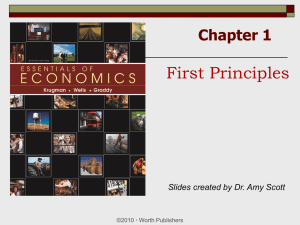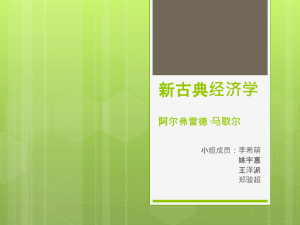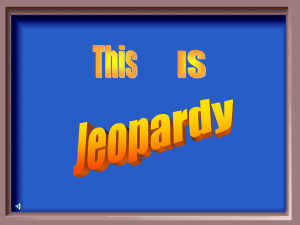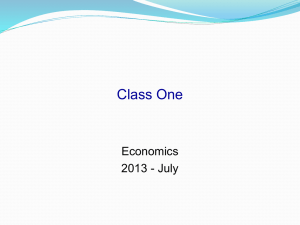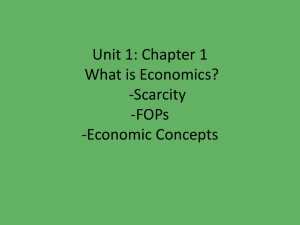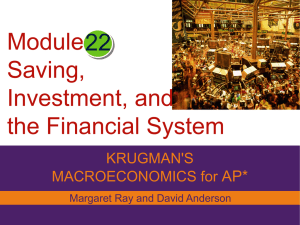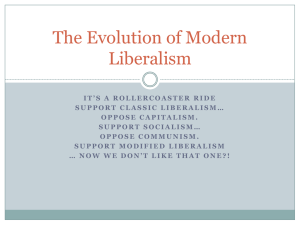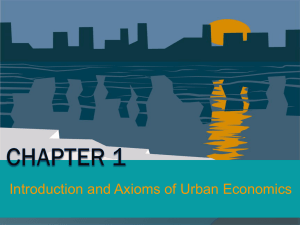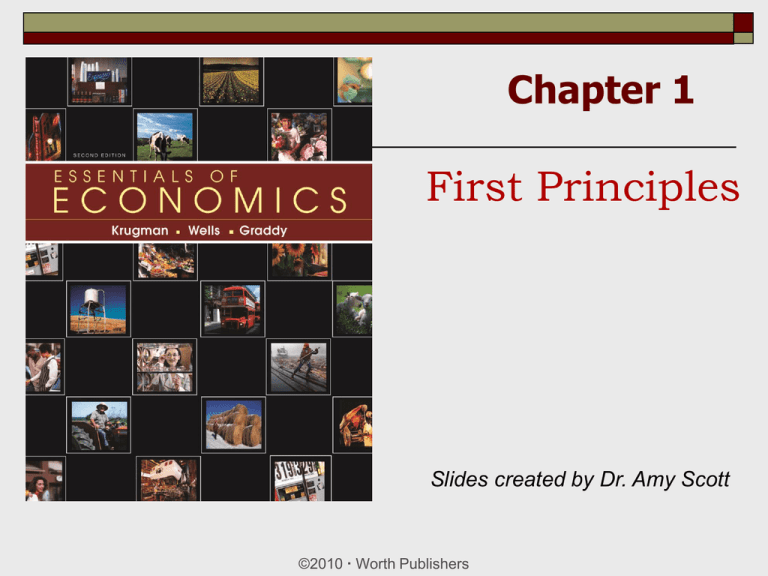
Chapter 1
First Principles
Slides created by Dr. Amy Scott
©2010 Worth Publishers
Common Ground
One must choose
To understand how an
economy works, you need to
understand more than how
individuals make choices.
Through the study of economics, we will
discover common principles about
individual choice and interaction.
Chapter Objectives
1. What is Economics?
2. Three Principles
A. Individual Choice
A set of principles for understanding the economics of how
individuals make choices
B. Choice Interaction
A set of principles for understanding how individual choices
interact
C. Economy-wide Interaction
A set of principles for understanding economy-wide
interactions
What is Economics?
Economics: social science that studies the production,
distribution and consumption of goods and services from
the Greek oikonomia meaning administration or
management of a household
Economy: system for coordinating society’s productive
activities
Market economy: an economy in which decisions about
production and consumption are made by individual
producers and consumers
Learning the Language of Economics:
Definitions
Microeconomics: branch of economics concerned with
how people make decisions and how these decisions
interact
Macroeconomics: branch of economics concerned with
the overall economy
Market failure: when individual pursuits of self-interest
lead to bad results for society
Learning the Language of Economics:
More Definitions
Invisible hand: Refers to the idea that individual
pursuit of self-interest can lead to good results for
society as a whole
Adam Smith 1776 An Inquiry into the Nature and
Causes of the Wealth of Nations “It is not from the
benevolence of the butcher, the brewer, or the baker
that we expect our dinner, but from their regard to
their own interest.”
Recession: a downturn in the economy
Economic growth: growing ability of the economy to
produce goods and services
Which of the following statements describe
features of a market economy?
1.
2.
3.
4.
The pursuit of one’s own self-interest sometimes
results in market failure.
The invisible hand harnesses the power of self-interest
for the good of society
A central authority makes decisions about production
and consumption.
Growth in a market economy is steady and without
fluctuations.
Three Principles:
Principle #1: Individual Choice
Individual choice is the decision by an individual of
what to do, which necessarily involves a decision of
what not to do
Basic principles behind the individual choices:
A. Resources are scarce.
B. The real cost of something is what you
must give up to get it.
C. “How much?” is a decision at the margin.
D. People take advantage of opportunities to
make themselves better off.
Basic Principles of Individual Choice
Resources
A resource is anything that can be used to produce
something else.
Ex.: Land, labor (time of workers), capital (machines)
Resources are scarce – the quantity available is not large
enough to satisfy all productive uses.
Ex.: Petroleum, lumber, intelligence
Basic Principles of Individual
Choice: Opportunity Cost
The
real cost of an item is its opportunity
cost: what you must give up in order to
get it.
Also defined as the value of the next
best alternative.
LeBron James
understood the concept
of opportunity cost.
Opportunity cost is crucial to understanding individual
choice:
Ex.: The cost of attending the economics class is what
you must give up to be in the classroom during the
lecture.
Sleep? Watching TV? Rock climbing? Work?
All costs are ultimately opportunity costs.
Basic Principles of Individual Choice
Opportunity Cost (Continued)
I WOULD RATHER BE SURFING THE INTERNET
Opportunity cost is about what you have to forgo to
obtain your choice.
The bumper stickers that say “I would rather be …
(fishing, golfing, swimming, etc…)” are referring to the
“opportunity cost.”
The opportunity cost of attending college is high: it’s the
cost of tuition and housing plus the forgone salary you
could have earned.
Got a Penny?
At many cash registers there is a little basket full of
pennies. People are encouraged to use the basket to round
their purchases up or down.
If it’s too small a sum to worry about, why calculate prices
that exactly? Why do we have pennies?
Sixty years ago, a penny was equivalent to 30 seconds
worth of work—it was worth saving a penny if doing so
took less than 30 seconds. But wages have risen along
with overall prices. Today a penny is therefore equivalent
to just over 2 seconds of work—and so it’s not worth the
opportunity cost of the time it takes to worry about a
penny more or less.
The rising opportunity cost of time in terms of money has
turned a penny from a useful coin into a nuisance.
Basic Principles of Individual Choice
Marginal Analysis
You
make a trade-off when you compare the costs with
the benefits of doing something.
Many
decisions are not “either-or” but instead “how
much.”
Some of you may decided not to study for the
economics exam but many of you will decide to
study. The question is how much: five hours, eight
hours or seventeen hours?
Decisions
about whether to do a bit more or a bit less of
an activity are marginal decisions.
Basic Principles of Individual Choice
Marginal Analysis (continued)
Making trade-offs at the margin: comparing the costs
and benefits of doing a little bit more of an activity
versus doing a little bit less.
Ex.: Studying one more hour, eating one more cookie,
buying one more CD, etc.
The study of such decisions is known as marginal
analysis.
Basic Principles of Individual Choice
Exploiting Opportunities
People
usually take advantage of opportunities to make
themselves better off.
People
respond to incentives.
Ex.: If the price of parking in Manhattan rises,
commuters who can find alternative ways to get to their
job will save money.
Incentives:
anything that offers rewards to people who
change their behavior.
Pay for Grades?
A few years ago, some Florida schools offered actual
cash bonuses to students who scored high on the
state’s standardized exams.
Why?
To motivate the students to take the exams as seriously
as the school administrators did (Florida introduced a
pay-for-performance scheme for schools: schools
whose students earned high marks on the state exams
received extra state funds).
Did it work?
Yes. Some Florida schools that have introduced rewards
for good grades on state exams report substantial
improvements in student performance.
A Woman’s Work
In 1900, only 6 percent of married women worked for
pay outside the home.
By 2005, the number was about 60 percent. This
change is in part due to changing attitudes, invention,
and the growing availability of home appliances,
especially washing machines.
In pre-appliance days, the opportunity cost of working
outside the home was very high: it was something
women typically did only in the face of dire financial
necessity.
With modern appliances, the opportunities available to
women changed—and the rest is history.
Which of the four principles of individual choice do
the following situations illustrate?
You are on your third trip to a restaurant’s All You Can
Eat dessert buffet and are feeling very full. Although it
would cost you no additional money, you forgo a slice
of coconut cream pie but have a slice of chocolate cake.
1. opportunity cost
2. resources are scarce
3. people usually exploit
opportunities to make
themselves better off
4. marginal analysis
Which of the four principles of individual choice do
the following situations illustrate?
Even if there were more resources in the world, there
would still be scarcity.
1. opportunity cost
2. resources are scarce
3. people usually exploit
opportunities to make
themselves better off
4. marginal analysis
Which of the four principles of individual choice do
the following situations illustrate?
Different teaching assistants teach several Economics
101 tutorials. Those taught by the teaching assistants
with the best reputations fill up quickly, with spaces left
unfilled in the ones taught by assistants with poor
reputations.
1. opportunity cost
2. resources are scarce
3. people usually exploit
opportunities to make
themselves better off
4. marginal analysis
Which of the four principles of individual choice do
the following situations illustrate?
To decide how many hours per week to exercise, you
compare the health benefits of one more hour of
exercise to the effect on your grades of one less hour
spent studying.
1. opportunity cost
2. resources are scarce
3. people usually exploit
opportunities to make
themselves better off
4. marginal analysis
You make $45,000 per year at your current job with Whiz
Kids Consultants. You are considering a job offer from
Brainiacs, Inc., which will pay you $50,000 per year.
The increased time spent commuting to your new job is
an opportunity cost of accepting the new job.
1. True
2. False
You make $45,000 per year at your current job with Whiz
Kids Consultants. You are considering a job offer from
Brainiacs, Inc., which will pay you $50,000 per year.
The $45,000 salary from your old job is an opportunity
cost of accepting the new job.
1. True
2. False
You make $45,000 per year at your current job with Whiz
Kids Consultants. You are considering a job offer from
Brainiacs, Inc., which will pay you $50,000 per year.
The more spacious office at your new job is an
opportunity cost of accepting the new job.
1. True
2. False
Principle #2:
Choice Interaction
Interaction of choices—my choices affect your choices, and
vice versa—is a feature of most economic situations.
Principles that underlie the interaction of individual choices:
A. There are gains from trade.
B. Markets move toward equilibrium.
C. Resources should be used as efficiently as possible
to achieve society’s goals.
D. Markets usually lead to efficiency.
E. When markets don’t achieve efficiency, government
intervention can improve society’s welfare.
Basic Principles of Choice Interaction
Gains from Trade
In a market economy, individuals engage in trade:
Trade: individuals provide goods and services to others
and receive goods and services in return.
There are gains from trade: people can get more of
what they want through trade than they could if they
tried to be self-sufficient.
Specialization: when each person specializes in the
task that he or she is good at performing.
There Are Gains From Trade
All Rights Reserved.
Ed Frascino from cartoonbank.com.
© The New Yorker Collection 1991
This increase in output is due to specialization: each person specializes
in the task that he or she is good at performing.
“I hunt and she gathers – otherwise we couldn’t make ends meet.”
The economy, as a whole, can produce more when each person
specializes in a task and trades with others.
Basic Principles of Choice Interaction
Equilibrium
An
economic situation is in equilibrium
when no individual would be better off
doing something different.
Any
time there is a change, the
economy will move to a new equilibrium.
Ex.:
What happens when a new checkout line
opens at a busy supermarket?
Choosing Sides
Before there were formal traffic laws, there were
informal “rules of the road.”
These rules included an understanding that people
would normally keep to one side of the road.
Why would some places choose the right and others,
the left?
Dependent upon the dominant form of “traffic” in that particular
area
Once established, the rule of the road would be selfenforcing—that is, it would be an equilibrium.
This rule even lends itself to pedestrians
Most people in the US walk on the right while those in England
and France tend to walk on the left
Basic Principles of Choice Interaction
Efficiency vs. Equity
An economy is efficient if it takes all opportunities to
make some people better off without making other
people worse off.
Equity means that everyone gets his or her fair share.
Since people can disagree about what’s “fair,” equity isn’t
as well-defined a concept as efficiency.
Ex.: Should economic policy makers always strive to
achieve economic efficiency?
Ex.: Should the payment of taxes be efficient or
equitable?
Basic Principles of Choice Interaction
Efficiency vs. Equity (Continued)
Ex.:
Handicapped-designated parking spaces in a busy
parking lot
A conflict between:
equity, making life “fairer” for handicapped people,
and
efficiency, making sure that all opportunities to make
people better off have been fully exploited by never letting
parking spaces go unused.
How far should policy makers go in promoting equity over
efficiency?
Basic Principles of Choice Interaction
Markets Usually Lead to Efficiency
The
incentives built into a market economy already
ensure that resources are usually put to good use.
Opportunities
wasted.
Exceptions:
to make people better off are not
market failure, the individual pursuit of
self-interest found in markets makes society worse off
the market outcome is inefficient.
Basic Principles of Choice Interaction
Government Intervention Can Improve Society’s Welfare
Why
do markets fail?
actions have side effects not taken into account
by the market (externalities).
Individual
One
party prevents mutually beneficial trades from
occurring in the attempt to capture a greater share of
resources for itself.
Some
goods cannot be efficiently managed by markets.
Ex.: Freeways in L.A. after earthquake in 1994
Restoring Equilibrium on the Freeways
In 1994, a powerful earthquake struck the Los Angeles area, causing
several freeway bridges to collapse, disrupting the normal commuting
routes of hundreds of thousands of drivers.
In the immediate aftermath of the earthquake, there was great
concern about the impact on traffic, since motorists would now have to
crowd onto alternative routes or detour around the blockages by using
city streets.
Public officials and news programs warned commuters to expect
massive delays and urged them to avoid unnecessary travel,
reschedule their work to commute before or after the rush, or to use
mass transit.
These warnings were unexpectedly effective a new equilibrium was
reached.
Restoring Equilibrium on the Freeways
(cont’d)
In fact, in the first few days following the quake, those who maintained
their regular commuting routine actually found the drive to and from
work faster than before!!!
Of course, this situation could not last. As word spread that traffic was
actually not bad at all, people abandoned their less convenient new
commuting methods and reverted to their cars—and traffic got steadily
worse.
Within a few weeks after the quake, serious traffic jams had appeared.
After a few more weeks, however, the situation stabilized: the reality of
worse-than-usual congestion discouraged enough drivers to prevent the
nightmare of citywide gridlock from materializing. Los Angeles traffic, in
short, had settled into a new equilibrium, in which each commuter was
making the best choice he or she could, given what everyone else was
doing.
Directions: Which of the five principles of
interaction is illustrated in the situations described?
Using the college Web site, any student who wants to
sell a used textbook for at least $30 is able to sell it to
another who is willing to pay $30.
1. gains from trade
2. Markets move toward equilibrium.
3. Resources should be used as efficiently as
possible to achieve society’s goal.
4. Markets usually lead to efficiency.
5. When markets don’t achieve efficiency,
government intervention can improve society’s
welfare.
Directions: Which of the five principles of
interaction is illustrated in the situations described?
At a college tutoring co-op, students can arrange to
provide tutoring in subjects they are good in (like
economics) in return for receiving tutoring in subjects
they are poor in (like philosophy).
1. gains from trade
2. Markets move toward equilibrium.
3. Resources should be used as efficiently as
possible to achieve society’s goal.
4. Markets usually lead to efficiency.
5. When markets don’t achieve efficiency,
government intervention can improve society’s
welfare.
Directions: Which of the five principles of
interaction is illustrated in the situations described?
The local municipality imposes a law that requires bars
and nightclubs near residential areas to keep their noise
levels below a certain threshold.
1. gains from trade
2. Markets move toward equilibrium.
3. Resources should be used as efficiently as
possible to achieve society’s goal.
4. Markets usually lead to efficiency.
5. When markets don’t achieve efficiency,
government intervention can improve society’s
welfare.
Directions: Which of the five principles of
interaction is illustrated in the situations described?
To provide better care for low-income patients, the
local municipality has decided to close some
underutilized neighborhood clinics and shift funds to the
main hospital.
1. gains from trade
2. Markets move toward equilibrium.
3. Resources should be used as efficiently as
possible to achieve society’s goal.
4. Markets usually lead to efficiency.
5. When markets don’t achieve efficiency,
government intervention can improve society’s
welfare.
Directions: Which of the five principles of
interaction is illustrated in the situations described?
On the college Web site, books of a given title with
approximately the same level of wear and tear sell for
about the same price.
1. gains from trade
2. Markets move toward equilibrium.
3. Resources should be used as efficiently as
possible to achieve society’s goal.
4. Markets usually lead to efficiency.
5. When markets don’t achieve efficiency,
government intervention can improve society’s
welfare.
The Following Describes an Equilibrium
Situation. True or False?
The restaurants across the street from the university
dining hall serve better-tasting and cheaper meals than
those served at the university dining hall. The vast
majority of students continue to eat at the dining hall.
1. True
2. False
Which of the following describes an
equilibrium situation? Which does not?
You currently take the subway to work. Although taking
the bus is cheaper, the ride takes longer. So you are
willing to pay the higher subway fare in order to save
time.
1. True
2. False
Principle #3:
Economy-Wide Interactions
Three principles underlie economy-wide interactions:
A. One person’s spending is another person’s
income.
Economy
is linked and changes in spending behaviors have
repercussions throughout the economy
B. Overall spending sometimes gets out of line with
the economy’s productive capacity.
The
amount of goods and services people want to buy
sometimes does not match the amount of goods and services the
economy can produce.
c. Government policies can change spending.
Government
uses three tools (government spending, taxes and
quantity of money in circulation) that can have a large impact on
the economy.
Explain how each of the following examples illustrates one
of the three principles of economy-wide interactions.
The White House urged Congress to pass major tax
cuts in the spring of 2001, when it became clear that
the U.S. economy was experiencing a slump.
1. One person’s spending is another person’s income.
2. Overall spending doesn’t match the economy’s productive
capacity.
3. Government policies can change spending.
Explain how each of the following examples illustrates one
of the three principles of economy-wide interactions.
Oil companies are investing heavily in projects that will
extract oil from the “oil sands” of Canada. In
Edmonton, Alberta, near the projects, restaurants and
other consumer businesses are booming.
1. One person’s spending is another person’s income.
2. Overall spending doesn’t match the economy’s productive
capacity.
3. Government policies can change spending.
Explain how each of the following examples illustrates one
of the three principles of economy-wide interactions.
In the mid-2000s, Spain, which was experiencing a big
housing boom, also had the highest inflation rate in
Europe.
1. One person’s spending is another person’s income.
2. Overall spending doesn’t match the economy’s productive
capacity.
3. Government policies can change spending.
Summary
1.
2.
3.
4.
1 of 4
All economic analysis is based on a list of basic principles
which apply to three levels of economic understanding.
First: how individuals make choices
Second: how these choices interact
Third: how the economy functions overall
Individual choice is the basis of economics. Everyone has
to make choices about what to do and what not to do.
Choices must be made because resources—anything that
can be used to produce something else—are scarce.
Because people must choose from limited alternatives, the
true cost of anything is what you must give up to get it— all
costs are opportunity costs.
Summary
5.
6.
7.
2 of 4
Many economic decisions involve questions not of “whether”
but of “how much”. Decision makers perform a trade-off
at the margin—by comparing the costs and benefits of doing
a bit more or a bit less. These are called marginal
decisions, and the study of them, marginal analysis,
plays a central role in economics.
The study of how people should make decisions is also a
good way to understand actual behavior. Individuals usually
exploit opportunities to make themselves better off. If
opportunities change, so does behavior: people respond to
incentives.
Interaction—that my choices depend on your choices, and
vice versa, adds another level to economic understanding.
Summary
8.
9.
10.
3 of 4
Interaction originates because there are gains from trade:
by trading goods and services with one another, members
of an economy can all be made better off. Gains from trade
come from specialization, when individuals specialize in
the tasks they are good at.
Economies normally move toward equilibrium—a situation
where no individual can be made better off by taking a
different action.
There is often a trade-off between equity and
efficiency. An economy is efficient if all opportunities to
make some people better off without making other people
worse off are taken. Equity, or fairness, is also desirable.
Summary
11.
12.
13.
14.
15.
4 of 4
Markets usually lead to efficiency, with some well-defined
exceptions.
When markets fail and do not achieve efficiency
government intervention can improve society’s welfare.
One person’s spending is another person’s income.
Overall spending in the economy can get out of line with the
economy’s productive capacity, leading to recession or
inflation.
Governments have the ability to strongly affect overall
spending, an ability they use in an effort to steer the
economy between recession and inflation.
The End of Chapter 1
Coming attraction
Chapter 2:
Economic Models:
Trade-offs and Trade

